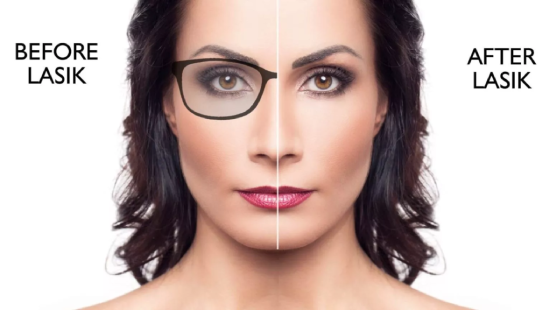






Are you tired of wearing glasses or dealing with contact lenses?
Do you dream of waking up in the morning with perfect vision? Well, you're in luck! Thanks to advancements in medical technology, LASIK laser has emerged as a game-changer in the field of vision correction.
LASIK, which stands for Laser-Assisted In Situ Keratomileusis, is a surgical procedure that uses laser technology to reshape the cornea, the transparent front part of the eye. By reshaping the cornea, LASIK laser can correct refractive errors such as nearsightedness, farsightedness, and astigmatism, thus eliminating the need for glasses or contact lenses.
The procedure is relatively quick and painless, typically taking less than 30 minutes to complete. It begins with the surgeon creating a thin flap on the cornea using a microkeratome or a femtosecond laser. Once the flap is created, the surgeon uses an excimer laser to remove a specific amount of corneal tissue, depending on the individual's prescription.
Another advantage of LASIK laser is its fast recovery time. Most patients experience improved vision within a day or two after the surgery, with minimal discomfort during the healing process. The corneal flap created during the procedure typically heals on its own, eliminating the need for stitches or bandages.
Moreover, LASIK laser offers long-lasting results. Once the cornea has been reshaped, the changes are permanent, and the majority of patients enjoy the benefits of improved vision for years to come. However, it's important to note that the procedure may not prevent age-related changes in vision, such as presbyopia, which typically occurs around the age of 40 and may require reading glasses.
Of course, like any surgical procedure, LASIK laser does come with some risks and potential complications. These can include dry eyes, glare or halos around lights, fluctuations in vision, or even the need for follow-up surgeries in some cases. Therefore, it's important for individuals considering LASIK to consult with a qualified ophthalmologist to evaluate their suitability for the procedure and to discuss the potential risks and benefits.
In conclusion, LASIK laser has revolutionized the field of vision correction, providing a safe, effective, and long-lasting alternative to glasses and contact lenses. With its high success rate, fast recovery time, and permanent results, LASIK laser has become an increasingly popular choice for individuals seeking freedom from visual aids. So, if you're tired of relying on glasses or contacts, LASIK laser may just be the answer to your vision woes. Talk to your eye doctor today to find out if you're a good candidate for this life-changing procedure!

Who Is a Good Candidate for LASIK Surgery?
To have LASIK surgery, you need to meet certain requirements. Here are some of them:
You should be 18 years or older (ideally, over 21 years old, when vision is more likely to have stopped changing).
Your eye prescription should not have changed much in the last year.
Your refractive error must be one that can be treated with LASIK.
Your corneas need to be thick enough and healthy, and your overall eye health must be generally good.
You need to have realistic expectations about what LASIK can and cannot do for you.
Who are not candidates for LASIK ?
An unstable (changing) refractive error
Extreme levels of myopia, hyperopia or astigmatism
Severe dry eye
Corneas that are too thin
Corneal scars or disease
Keratoconus (cone-shaped cornea)
Advanced glaucoma
A cataract affecting vision
A history of having certain eye infections
Diabetes that is not controlled well
Also, women who are pregnant or breastfeeding should not have LASIK. This is due to vision changes that can happen during pregnancy.
Contoura LASIK
Contoura LASIK is an advanced form of laser eye surgery that aims to provide patients with sharper and more precise vision correction. It uses topographic measurements of the cornea, which is the outermost layer of the eye, to create a highly personalized treatment plan.
This procedure begins with mapping the cornea's unique shape and contours using specialized technology. These measurements are then used to guide the laser during the surgery, ensuring a more accurate reshaping of the cornea. By customizing the treatment based on the patient's individual corneal topography, Contoura LASIK aims to provide better visual outcomes and reduce the risk of complications.
The benefits of Contoura LASIK include a higher chance of achieving 20/20 vision or better, improved contrast sensitivity, reduced nighttime glare and halos, and enhanced overall visual quality. It is often considered a highly effective and safe option for individuals seeking to reduce their dependence on glasses or contact lenses.
However, not everyone may be a suitable candidate for Contoura LASIK. Factors such as the thickness of the cornea, the stability of the prescription, and certain eye conditions may exclude some individuals from undergoing this procedure. It is crucial to consult with an experienced eye surgeon to determine the best treatment option for individual needs and circumstances.
Overall, Contoura LASIK is a state-of-the-art technology that offers a personalized approach to laser eye surgery, resulting in potential improvements in visual clarity, crispness, and comfort.
Pre-Lasik Workup
Before undergoing Lasik surgery, it is crucial to undergo a comprehensive eye examination to determine whether you are a suitable candidate for the procedure. This evaluation, also known as a pre-Lasik work-up, consists of several tests and assessments to ensure that your eyes are healthy enough for the surgery and that you will achieve optimal results.
The pre-Lasik work-up typically begins with a thorough examination of your eye health. An ophthalmologist will inspect the various structures of your eye, including the cornea, retina, and optic nerve, for any abnormalities or diseases that may affect the outcome of the surgery. Additionally, they will evaluate your overall ocular health, checking for conditions such as dry eyes or allergies, which may require treatment or management before surgery.
One of the most critical aspects of the pre-Lasik work-up is the measurement of your corneal thickness. A thin cornea may increase the risk of complications during the surgery, so it is essential to establish whether your cornea has enough thickness to safely proceed with the procedure.
To determine your corneal thickness, a test called pachymetry is performed. This simple procedure involves using a special instrument called a pachymeter to measure the thickness of your cornea. The results of this test are crucial in determining if you are a suitable candidate for Lasik surgery.
Another important step in the pre-Lasik work-up is the assessment of your refractive error, which is the primary reason for undergoing Lasik surgery. This is typically done using a series of advanced diagnostic devices, such as autorefractors and wavefront analyzers, to measure the exact degree of your nearsightedness, farsightedness, or astigmatism.
These devices provide highly accurate measurements of your eye's refractive error, allowing the surgeon to plan the exact amount of corneal tissue to be removed during the surgery. This precision is vital for achieving optimal visual outcomes, as it ensures that your cornea is reshaped to the correct degree, resulting in improved vision after the procedure.
Lastly, the pre-Lasik work-up may also include various additional tests and assessments, depending on your unique case. These may include tests for corneal topography, which create a detailed map of your cornea's shape and curvature, as well as assessments for pupil size and tear film quality.
Overall, the pre-Lasik work-up is a comprehensive evaluation of your eye health and refractive error, which determines whether you are a suitable candidate for Lasik surgery. The tests and assessments performed during this process are crucial in ensuring your safety and achieving the best possible visual outcomes.
So, if you've been considering Lasik eye surgery, don't forget about the pre-operative work-up. It is an essential step that will not only provide reassurance about the success of the surgery but also ensure that you can kiss goodbye to glasses or contacts for good.
Remember, always consult with a qualified ophthalmologist to discuss your options and determine if Lasik surgery is right for you.
Post operative care after Lasik Laser
After undergoing LASIK laser eye surgery, it is important to follow specific post-operative care instructions to ensure optimal healing and a successful outcome. Here are some general guidelines for post-operative care after LASIK:
Rest: It is important to rest your eyes immediately after surgery to give them time to heal. Avoid activities that strain your eyes, such as reading or using electronic devices, for the first 24 to 48 hours.
Use prescribed eye drops: Your surgeon will provide you with a set of eye drops to use after LASIK surgery. These drops help reduce inflammation and prevent infection. Follow the instructions provided by your surgeon and use the prescribed drops as directed.
Avoid rubbing your eyes: For at least a week following LASIK, it is crucial to avoid rubbing, touching, or applying pressure to your eyes. This can disrupt the healing process and increase the risk of complications.
Wear protective eyewear: In the first few days after LASIK, it is recommended to wear protective eyewear such as sunglasses to shield your eyes from bright sunlight, wind, and dust. This helps prevent any potential irritants or foreign substances from entering your eyes and causing complications.
Follow a modified schedule: Your surgeon may advise you to modify your daily activities for a certain period after LASIK. This might include avoiding swimming, hot tubs, saunas, or any activity that could expose your eyes to impurities during the healing process.
Attend follow-up visits: Regular follow-up visits are necessary to monitor your healing progress and address any concerns. Your surgeon will schedule these appointments and may make adjustments to your post-operative care regimen if necessary.
Avoid strenuous: For a few weeks following LASIK, you should avoid activities such as heavy lifting, intense exercise, or contact sports. These activities can strain the eyes and increase the risk of complications.
Maintain a clean environment: Keep your surroundings clean and avoid exposure to potential irritants or pollutants that could adversely affect your eyes during the healing period.
It is essential to remember that every patient's post-operative care instructions may vary slightly depending on their specific needs and the recommendations of their surgeon. Following all instructions and attending follow-up visits are crucial to ensuring a successful recovery from LASIK laser eye surgery